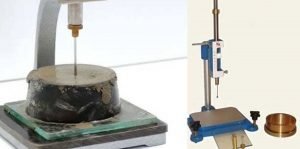Consistency of Cement: 8 Procedure Steps, Apparatus & Important Points
Consistency of cement is the amount of water that can be added to the cement to produce the ingredients of concrete and a uniform paste of cement.
To attain standard consistency or normal consistency of cement, the Consistency of cement test is performed to determine the amount of water content that is to be added.

When the water is mixed with cement it starts hydration and an increase in Water cement ratio occurs if excessive or less water is added in cement. So, the consistency of the cement test is used to determine the amount of water content that is to be added.
Determination of Standard Consistency of Cement:
Apparatus for Consistency of Cement:
- Vicat Apparatus
- Needles
- Moveable Rod
- Graduated Scale
- Vicat Mould

Vicat Apparatus:
This apparatus consists of a frame having a movable rod with a cap at one end and any one of the attachments which are interchangeable at another end.
Needles:
There are several needles used for the determination of standard consistency of cement such as;
Needle for Initial Setting Time;
This needle is having a cross-sectional area of 1mm square and the end of the needle is flat.
Needle for Final Setting Time;
This needle is having a cross-sectional area of 1mm square and is circular and with a metal attachment, this needle is fitted.
Moveable Rod:
This rod carries an indicator which moves over a graduated scale attached to the frame.
Graduated Scale:
In length the graduated scale is 40mm and 1mm is the smallest division of the scale.
Vicat Mould:
Single Mould;
This mould is in the form of a frustum of a cone having an internal diameter of 60+/-0.5mm at the top, at the bottom internal diameter is 70 +/- 0.5mm and 40 +/_ 0.5mm height.
Split type Vicat mould;
This mould is used as an alternative to single mould and consist of a split ring having an internal diameter 80+/- 0.1mm and 40+/_0.5mm height. With a suitable clamping ring split mould is provided and also provided with non-porous base plate.
The Procedure of Standard Consistency of Cement:
There are the following steps in the procedure as given below;
- On a level, the base keeps the Vicat apparatus and keep the bearing movable rod to its highest position and pin it when using the Vicat apparatus with a dashpot.
- For determining standard consistency to the movable rod attach the plunger and work the plunger for a number of times and in a pan, take 400 gm of cement & in a beaker weighed quantity of water.
- With the water added to cement prepare a paste and at the time of adding water to cement start a stopwatch. Then on a non-porous plate keep the Vicat mould and fill the cement paste.
- After completely filling the mould shake it slightly to expel the air and making surface level with the top of the moulder, smooth off the surface of the paste & cement paste prepared is the test block.
- Under the movable rod, place the test block resting on the non-porous plate.
- To touch the surface of the cement paste, lower the plunger gently and release quickly and then to the surface of the cement paste remove the pin holding the movable bearing rod and release quickly. After filling the mould this operation shall be done immediately.
- Until plunger penetrates to a point 5mm to 7mm from the bottom of the Vicat mould which is read on the scale, prepare trial test specimens with varying percentages of water.
- By weight of the dry cement, express the water required as a percentage.
Observations and Calculations:
- Weight of cement taken = ___
- Initial percentage % of water added to cement = ___
- Water quantity added to cement = ___
Standard Consistency of Cement as Percentage % = (Weight of Water Added / Weight of Cement) x 100.
S.NO | QUANTITY OF WATER ADDED in ml | DEPTH OF PENETRATION In mm |
1. | ||
2. | ||
3. |
Important Points:
There are the following points to be noted such as;
- Gauging time should not be more than 5 minutes and less than 3 minutes and gauging time is the time elapsing from the time of adding water to the dry cement.
- At room temperature 27 C +/- 2 C the test should be conducted.
- On the working table, there should be no vibration.
- During every repetition, the plunger should be cleaned.

